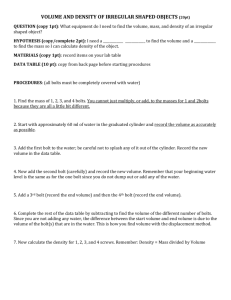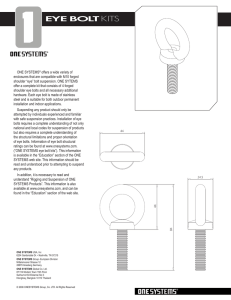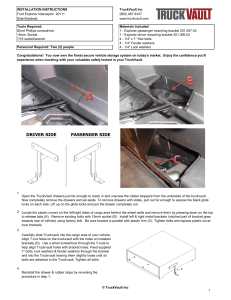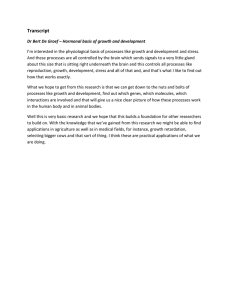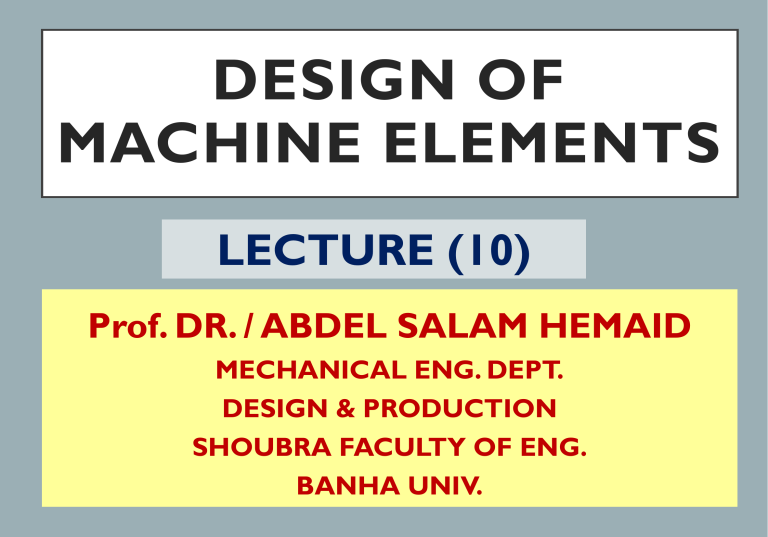
DESIGN OF MACHINE ELEMENTS LECTURE (10) Prof. DR. / ABDEL SALAM HEMAID MECHANICAL ENG. DEPT. DESIGN & PRODUCTION SHOUBRA FACULTY OF ENG. BANHA UNIV. LECTURE (09) THREADED JOINTS-CON. ECCENTRIC LOAD PERPENDICULAR TO AXIS OF BOLT • In this analysis, the following assumptions are made: • (i) The bracket and the steel structure are rigid. • (ii) The bolts are fitted in reamed and ground holes. • (iii) The bolts are not preloaded and there are no tensile stresses due to initial tightening. • (iv) The stress concentration in threads is neglected. • (v) All bolts are identical. ECCENTRIC LOAD PERPENDICULAR TO AXIS OF BOLT ECCENTRIC LOAD PERPENDICULAR TO AXIS OF BOLT The moment (P x e) tends to tilt the bracket about the edge C. As shown in Fig. (b), each bolt is stretched by an amount (d) which is proportional to its vertical distance from the point C. ECCENTRIC LOAD PERPENDICULAR TO AXIS OF BOLT ECCENTRIC LOAD PERPENDICULAR TO AXIS OF BOLT EXAMPLE 7.5 • The following data is given for the bracket illustrated in Fig.(a). P = 25 kN e = 100 mm l1 = 150 mm l2 = 25 mm • There is no pre-load in the bolts. The bolts are made of plain carbon steel 45C8 (Syt = 380 N/mm2) and the factor of safety is 2.5. Using the maximum shear stress theory, specify the size of the bolts. Example 7.6 A wall bracket is attached to the wall by means of four identical bolts, two at A and two at B, as shown in Fig. 7.21. Assuming that the bracket is held against the wall and prevented from tipping about the point C by all four bolts and using an allowable tensile stress in the bolts as 35 N/mm2, determine the size of the bolts on the basis of maximum principal stress theory. EXAMPLE 7.7 • A bracket is fastened to the steel structure by means of six identical bolts as shown in Fig. (a). Assume the following data: • l1 = 300 mm • l2 = 200 mm • l3 = 100 mm • l = 250 mm • P = 50 kN • Neglecting shear stress, determine the size of the bolts, if the maximum permissible tensile stress in any bolt is limited to 100 N/mm2. SOLUTION • Given P = 50 kN l = 250 mm (σ1)max. = 100 N/mm2 • Step I Maximum tensile force • The force P tends to tilt the bracket about edge C. • 𝛿 1 ∝ l1 𝛿 2 ∝ l2 𝛿 3 ∝ l3 • force ∝ stress because (P = σA) • stress ∝ strain because (σ = E 𝜖 ) • strain ∝ stretch because (𝜖 = 𝛿 /l) • P1 = Cl1 P2 = Cl2 • Pl = 2P1 l1 + 2P2 l2 + 2P3 l3 P3 = Cl3 EXAMPLE 7.8 • A cast iron bracket fixed to the steel structure is shown in Fig. (a). It supports a load P of 25 kN. There are two bolts at A and two bolts at B. The distances are as follows, • l1 = 50 mm l2 = 200 mm l = 400 mm • Determine the size of the bolts, if maximum permissible tensile stress in the bolt is 50 N/mm2. SOLUTION • Given P = 25 kN l = 400 mm (σt)max. = 50 N/mm2 • The bolts are subjected to following stresses: • (i) Direct tensile stress due to load P. • (ii) Tensile stress due to tendency of the bracket to tilt in clockwise direction about the edge C. • Step I Direct tensile force Since the bolts are identical, the direct tensile force on each bolt is given by, SOLUTION Step II Tensile force due to tendency of bracket to tilt The following assumptions are made: (i) All bolts are identical. (ii) The bracket and the structure are rigid. (iii) The bolts are not preloaded and there is no initial tensile stress due to tightening of the bolt. • (iv) As shown in Fig. (b), when the load tends to tilt the bracket about the edge C, each bolt is stretched by an amount (d), which is proportional to its distance from the tilting edge. Or, 𝛿 1 ∝ l1 𝛿 2 ∝ l2 P1” = C l1 P2” = C2 I2 • • • • • From Table 7.1, the standard size of the bolts is M36 (A = 817 mm2). 7.13 ECCENTRIC LOAD ON CIRCULAR BASE • The following assumptions are made: • (i) All bolts are identical. • (ii) The bearing and the structure are rigid. • (iii) The bolts are not preloaded and there is no tensile stress due to initial tightening. • (iv) The stress concentration in the threads is neglected. • (v) The bolts are relieved of shear stresses by using dowel pins. If P1 P2 … are the resisting forces induced in the bolts, P1 ∝ l1 or, P1 = Cl1 P2 = Cl2 P3 = Cl3 P4 = Cl4 where C is the constant of proportionality. (a) Four bolts are considered in the above analysis. If the procedure is repeated for n equally spaced bolts, we get the general expression in the following form: The force P1 has maximum value when the term (cos a) has minimum value. The minimum value of (cos α) is (–1), when (α = 180°). With reference to Fig. 7.26 (b), the bolt 1 will occupy the topmost position, at the farthest distance form C, when α = 180°, Substituting α = 180° • For a general case with n as number of bolts, EXAMPLE 7.11 • A round flange bearing, as shown in Fig. 7.26(b), is fastened to the machine frame by means of four cap screws spaced equally on a 300 mm pitch circle diameter. The diameter of the flange is 400 mm. The external force P is 25 kN, which is located at a distance of 150 mm from the machine frame. There are two dowel pins to take shear load. The cap screws are relieved of all shear force. Determine the size of the cap screws, if the maximum permissible tensile stress in the cap screw is limited to 50 2 N/mm . SOLUTION • Given 2a = 400 mm 2b = 300 mm P = 25 kN • l = 150 mm (σt)max. = 50 N/mm2 • Step I Maximum force on cap screw • It is assumed that the direction of the external force P is fixed and cap screws are located in such a way that two of them are equally stressed. From Eq. (7.18), EXAMPLE 7.13 • Figure shows the bracket used in a jib crane to connect the tie rod. The maximum force in the tie rod is 5 kN, which is inclined at an angle of 30° with the horizontal. The bracket is fastened by means of four identical bolts, two at A and two at B. The bolts are made of plain carbon steel 30C8 (Syt = 400 N/mm2) and the factor of safety is 5. Assume maximum shear stress theory and determine the size of the bolts. 7.14 TORQUE REQUIREMENT FOR BOLT TIGHTENING • A bolted assembly is tightened by applying force to the wrench handle and rotating the hexagonal nut. • In certain applications, as in case of the gasketed joint between the cylinder and the cylinder head of the engine, the bolts are tightened with a specific magnitude of pre-load Pi. It is necessary to determine the magnitude of the torque which will induce this pre-tension. The torque required to tighten the bolt consists of the following two factors: • (i) torque required to overcome thread friction and induce the pre-load, i.e., (Mt); and • (ii) torque required to overcome collar friction between the nut and the washer (Mt)c. • The torque required to overcome thread friction is given by,
